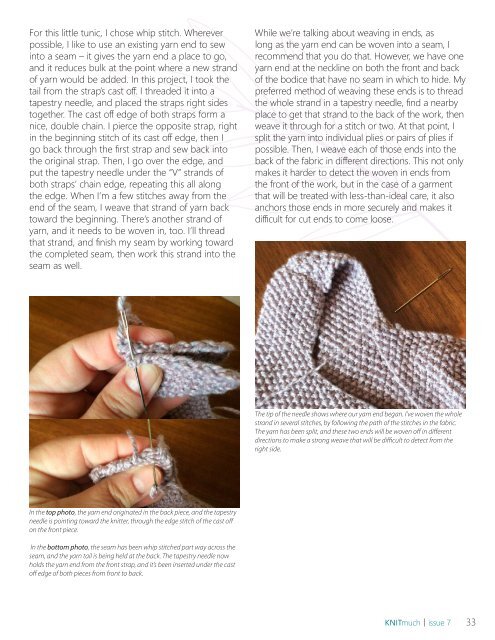KNITmuch | Issue 07
Welcome to a new issue of KNITmuch magazine! We review four yarns, two yarns created with natural fibers and two with acrylics. Check them out! See how they are constructed, the fiber content, how they knit up, and suggestions for knitting projects. I'm talking about Uptown Worsted Magix, a new addition to the Uptown Worsted collection that has anti-pilling properties you'll be excited about. Dreamy yarn, an acrylic yarn perfect for those soft socks, blankets and anything you want to feel cozy in. Another new yarn this year, Chic Sheep by Marly Bird is 100% merino wool by Red Heart. For natural fiber lovers check out the properties that make this an excellent choice for winter knitting. And for those who knit their summer clothes during the winter, included is our review of Papyrus yarn, a soft linen and cotton blend that offers cool and soft knits for the whole family. Don't miss our tutorials on steam blocking, how to write patterns for beginner knitters, the anatomy of a knitted beret and bunny ears decreases make an excellent motif for a baby blanket, and you know there's so much more.
Welcome to a new issue of KNITmuch magazine! We review four yarns, two yarns created with natural fibers and two with acrylics. Check them out! See how they are constructed, the fiber content, how they knit up, and suggestions for knitting projects.
I'm talking about Uptown Worsted Magix, a new addition to the Uptown Worsted collection that has anti-pilling properties you'll be excited about. Dreamy yarn, an acrylic yarn perfect for those soft socks, blankets and anything you want to feel cozy in.
Another new yarn this year, Chic Sheep by Marly Bird is 100% merino wool by Red Heart. For natural fiber lovers check out the properties that make this an excellent choice for winter knitting. And for those who knit their summer clothes during the winter, included is our review of Papyrus yarn, a soft linen and cotton blend that offers cool and soft knits for the whole family.
Don't miss our tutorials on steam blocking, how to write patterns for beginner knitters, the anatomy of a knitted beret and bunny ears decreases make an excellent motif for a baby blanket, and you know there's so much more.
Create successful ePaper yourself
Turn your PDF publications into a flip-book with our unique Google optimized e-Paper software.
For this little tunic, I chose whip stitch. Wherever<br />
possible, I like to use an existing yarn end to sew<br />
into a seam – it gives the yarn end a place to go,<br />
and it reduces bulk at the point where a new strand<br />
of yarn would be added. In this project, I took the<br />
tail from the strap’s cast off. I threaded it into a<br />
tapestry needle, and placed the straps right sides<br />
together. The cast off edge of both straps form a<br />
nice, double chain. I pierce the opposite strap, right<br />
in the beginning stitch of its cast off edge, then I<br />
go back through the first strap and sew back into<br />
the original strap. Then, I go over the edge, and<br />
put the tapestry needle under the “V” strands of<br />
both straps’ chain edge, repeating this all along<br />
the edge. When I’m a few stitches away from the<br />
end of the seam, I weave that strand of yarn back<br />
toward the beginning. There’s another strand of<br />
yarn, and it needs to be woven in, too. I’ll thread<br />
that strand, and finish my seam by working toward<br />
the completed seam, then work this strand into the<br />
seam as well.<br />
While we’re talking about weaving in ends, as<br />
long as the yarn end can be woven into a seam, I<br />
recommend that you do that. However, we have one<br />
yarn end at the neckline on both the front and back<br />
of the bodice that have no seam in which to hide. My<br />
preferred method of weaving these ends is to thread<br />
the whole strand in a tapestry needle, find a nearby<br />
place to get that strand to the back of the work, then<br />
weave it through for a stitch or two. At that point, I<br />
split the yarn into individual plies or pairs of plies if<br />
possible. Then, I weave each of those ends into the<br />
back of the fabric in different directions. This not only<br />
makes it harder to detect the woven in ends from<br />
the front of the work, but in the case of a garment<br />
that will be treated with less-than-ideal care, it also<br />
anchors those ends in more securely and makes it<br />
difficult for cut ends to come loose.<br />
The tip of the needle shows where our yarn end began. I’ve woven the whole<br />
strand in several stitches, by following the path of the stitches in the fabric.<br />
The yarn has been split, and these two ends will be woven off in different<br />
directions to make a strong weave that will be difficult to detect from the<br />
right side.<br />
In the top photo, the yarn end originated in the back piece, and the tapestry<br />
needle is pointing toward the knitter, through the edge stitch of the cast off<br />
on the front piece.<br />
In the bottom photo, the seam has been whip stitched part way across the<br />
seam, and the yarn tail is being held at the back. The tapestry needle now<br />
holds the yarn end from the front strap, and it’s been inserted under the cast<br />
off edge of both pieces from front to back.<br />
<strong>KNITmuch</strong> | issue 7<br />
33

















